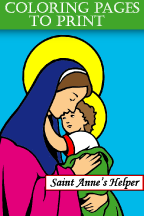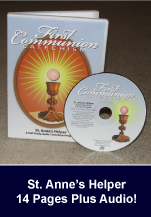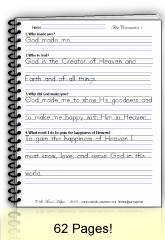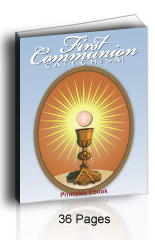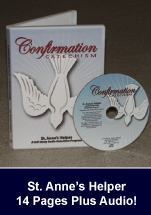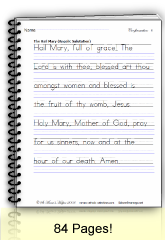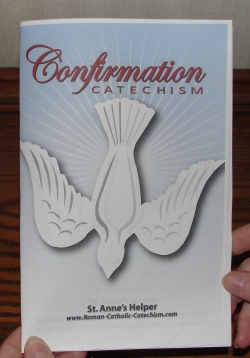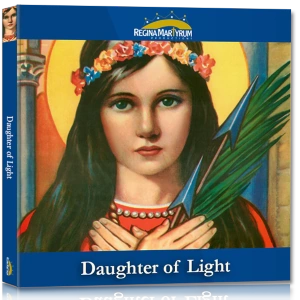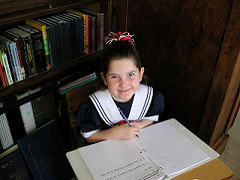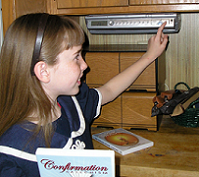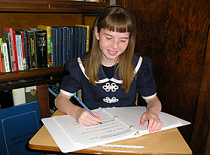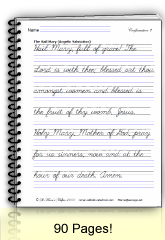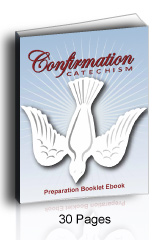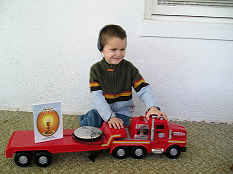- Home
- Catholic Homeschooling
- MODG Catholic Homeschool
MODG Catholic Homeschool Curriculum
Mother of Divine Grace School
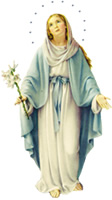
Mother of Divine Grace School, or MODG Catholic homeschool has a curriculum and a physical school powered by Laura Berquist. She is also the author of Designing Your Own Classical Curriculum and The Harp and Laurel Wreath.
After more than 25 years of marriage including eight years of sending our children to school and more than ten years of homeschooling, I am grateful to Laura Berquist for her advice in her books and book lists at MODG.
Basically she's applied a Great Books method to Catholic books. So many times, the Great Books idea sound so intellectually superior to the use of text books in school.
Well, I agree with authors who claim these things, IF -
and this is a most necessary IF in my life -
IF one uses good Catholic books with other books that will not harm the children's faith as per Pope Pius XI's Divini Illius Magistri.
1. Designing Your Own Classical Curriculum
Mother of Divine Grace's Catholic homeschool curriculum "is a particular application of Laura Berquist's recommendations in her book Designing Your Own Classical Curriculum."
For me, the most important K-12 studies are those that center around the catechism and teach the world as seen through real history and real books. Reading this book years ago helped our family.
Usually, math is math and science is science and most of the Catholic homeschools recommend the same books, yet history, literature, and religion are rife with dangers. Important dangers that can ruin lives.
Throughout the last many years Laura's perspective at MODG homeschool has helped me gather or reject books that have helped our family keep the Faith and live a happy life.
If you're wondering how to begin or how to supplement the the Catholic homeschool curriculum that you are using, read this book.
Use the Baltimore Catechism?
Disclosure: I show products that I think will help you. If you use my links, I may earn ad commissions at no extra cost to you. As an Amazon Associate I earn from qualifying purchases.
Many of us fear the very idea of designing our own curriculum. I know that I was very grateful that we had had lesson plans during our first years home after having sent our oldest children to school. Lesson plans give a "list of things to do". What happens though when you find that you'd rather use other books, or that you want to combine several children in one class? Laura's ideas were a huge help.
After several years using someone else's lesson plans you get an idea of books that you do and do not want to use. There came a point when we needed flexibility in choosing our books and resources. Laura's ideas were a big help here.
Those who are at this point yet still want lesson plans, especially if they have read Laura Berquist's Designing Your Own Classical Curriculum, might really appreciate using the curriculum at Mother of Divine Grace School.
Mrs. Berquist has "experimented with different materials and activities and has selected those that have been most successful." The syllabi (lesson plans, etc.) are complete K-12 and suggest books that you can use or replace and you can buy them at Emmanuel Books.
2. Harp And Laurel Wreath
The Harp and Laurel Wreath is Laura Berquist's book that recommends Poetry and Dictation for the MODG Classical Curriculum to use with her book Designing Your Own which offers more activities and authors to use throughout your curriculum.
Harp and Laurel contains a filing cabinet of nice resources from which to choose what works for your homeschooling situation. Designing teaches helpful principles.
Through the different stages, you can replace Laura's selections with your favorite choices. This is the beauty of "designing" our own Catholic homeschool curriculum. Today we have so many more Catholic resources easily available especially online. Use Harp and Laurel as a springboard for your individual lesson plans and book lists.
3. MODG Catholic Homeschool Curriculum
As per Laura Berquist's book, the MODG Catholic homeschool program uses four stages of learning. See a bit of an explanation below for each one:
A. The Primary Stage (K-2) – Learning to read and write well.
B. The Grammatical Stage (3-5) – Memorizing and writing from dictation.
C. The Dialectic Stage (6-9) – Analyzing what one reads.
D. Rhetorical Stage (10-12) – Rational discussion and persuasive writing.
I love this quote from the MODG Curriculum page:
- "Our curricular materials have been carefully examined to ensure that they are not opposed to the Catholic faith. While not every text in the program is explicitly Catholic, we avoid all materials which are opposed, explicitly or implicitly, to the truths of the Faith."
And this from St. Thomas Aquinas:
- "Now in those things that come about by nature and art, art works in the same way and uses the same sorts of tools as nature…. This is why art is said to imitate nature…. (I)n the acquisition of knowledge, the teacher leads the student to the knowledge of things the student previously did not know in the same way that someone leads himself to discover what he previously did not know." -- Saint Thomas Aquinas, De Magistro q. 11, a.1 of De Veritate
A. MODG Catholic Homeschool: Early Years
Laura Berquist's collection of classical Poetry and Dictation is called The Harp and the Laurel Wreath. It is a companion book to Designing Your Own Classical Curriculum.
The first section has Early Years materials that are very common and delightful as well. One of our favorites is Stopping By a Woods On A Snowy Evening, by Robert Frost.
The first selection are represented by: The Whole Duty of Children, by Robert Louis Stevenson. Stevenson's early works are fun for children because he was a child when he wrote them. Other dear poems are: Once I Saw a Little Bird, an old nursery rhyme; The Little Turtle; by Vachel Lindsay; and the sweet Furry Bear by A. A. Milne.
I'm not sure which Bible Mrs. Berquist used. What is called Psalm 23 the Douay Rheims Bible calls Psalm 22. There are dictations that include other Bible quotes, but you might want to replace these with your favorite quotes from the Douay-Rheims Bible.
She used the American Cardinal Readers for Dictations during the Early Years unit and it has simple and delightful ideas for memorization and dictation (where the child writes what he hears).
The length and complexity of assignments increases in her Grammatical and Dialetical stages and in the Rhetorical stage she offers questions (with optional answers) to encourage your students' thoughts about the selections.
All throughout the stages I think that it is very important to add the study of authors' lives because many authors are acclaimed as "classics" without qualification.
I try to make sure that the author wrote well and lived a good life. If he did not, at least I can be forewarned to check texts or warn the children.
Even a quick look at Wikipedia can be an easy way to begin to learn about an author's life. I think that is increasingly important to add what you know about the author and the history surrounding his works.
There is so much in print today that claims to be Catholic, authoritative, or good that simply isn't even useful; not to speak of what is harmful. Use the advice of Pope Pius XI in his encyclical Divini Illius Magistri to choose as the bee does as you read these works or choose others. Choose the best, and discuss or eliminate the rest.
If your older students are just beginning a Catholic classical curriculum they can read through the Early, Grammatical, and Dialectical stages, choosing the best (or your favorites), and simply read the rest for enjoyment. Many selections throughout the book are short and have questions that could be answered either orally or in written form.
Throughout her book, Laura recommends books that are appropriate for different children's ages and that compliment the subjects usually taught at those ages.
I find that her books are a God send when you're wanting to invent or supplement your curriculum with Catholic books. She has many resources on her MODG Catholic homeschool site including grade level booklets to guide you through any particular year.
B. MODG Catholic Homeschool: The Grammatical Stage
The Harp and Laurel Wreath during the Grammatical Stage uses poetry and dictations that are longer and of more substantial content.
Materials are drawn from the writing of such authors as Henry Wadsworth Longfellow, Oliver Wendell Holmes, Alfred Lord Tennyson, Ralph Waldo Emerson, Edgar Allen Poe and of more interest to us as Catholics a hymn from Saint Thomas Aquinas. You can choose your favorite poems, too.
There's also the classic Casey at the Bat, by Ernest Lawrence Thayer and famous historical figures like George Washington and Benjamin Franklin by Stephen Vincent Benet. These are not only longer than those during the Early Years, but they cover deeper subjects and carry one's mind through the joys, toils and sorrows of both imaginary and historical heroes.
The works to memorize are very practical for this age as learning both the Latin and English Anima Christi prayer and the Preamble to the United States Constitution , which is a short paragraph.
The dictations are from several different books, many by Hilda van Stockum. These can also be replaced with what you like, but these give a very good idea of what can be done with Grammatical Stage dictation.
Also, a student can combine Early and Grammatical stages if he is beginning at an older age. Most dictation assignments will delight the child or be useful in the future.
C. MODG Catholic Homeschool: The Dialectical Stage
The Harp and Laurel Wreath third unit contains Laura Berquist's list for Dialectical Stage Poetry and Dictation. These entries are a great start for your individual curriculum and show the length and complexity usually used at this level. It's nice to have a base from which to work.
The poetry given for this stage are from such writers as William Shakespeare, John Keats, Sir Walter Scott, and Alfred Lord Tennyson.
Many are short excerpts from their greater works. This is a gem if you are doing as Pope Pius XI taught in his encyclical Divini Illius Magistri and choosing as the bee from amongst the great writers so as to present the best to your students.
This way you do not have to sort through their work to find useful excerpts. These writers do not have a Catholic perspective in some of their stories.
I think that this is very important because so many of us read what are called by the twentieth century school systems as "classics" without knowing anything about the author and his life.
Here, Laura Berquist, has given an examples that are in common use in our western world and you can add what you know about the author and the history of his works without assigning the whole work. Mrs. Berquist has done some editing for you.
My favorite poem is James Whitcomb Riley's When the Frost Is on the Pumpkin. Why? I like the glorious picture of a fall harvest that it paints. Some of mine at this stage still definitely needed me to read it out loud since it has a conversational style in a bit of a southern dialect of English. Hallylooyer? Perhaps the rooster was saying Alleluia, etc. Appetisn? Growed? Hosses? In spite of spelling differences, these all add to the beautiful picture of a quaint farm in a peacefully bountiful autumn.
Memorization is from the Second Inaugural Address of Abraham Lincoln, March 4, 1865. You could replace it with other readings, too. See more books as recommended in her Designing Your Own Classical Curriculum and as available at Emmanuel Books. Personally, we like to have our children learn some longer prayers like prayers from the Missal and Prayer To St. Joseph.
The Dialectical Stage dictations are from several authors. Again, these simply give you a good idea of length and complexity. I think, too, that more from history and religion classes can be used here. Refer to Mrs. Berquist's early pages for many principles to remember.
If your students are starting a classical curriculum at an older age they can read through Early, Grammatical, and Dialectical stage texts by choosing the best (or your favorites) and simply reading the rest for enjoyment. You can also simply eliminate smaller works.
D. MODG Catholic Homeschool: The Rhetorical Stage
- Questions And Answers
The Harp and Laurel Wreath Rhetorical Stage is the fourth unit. As with each stage, you can customize with your favorites. She offers questions and optional answers to encourage further thought.
The Rhetorical unit starts with definitions that apply to poetry and is divided into three sections. The poetry for this stage is from various writers and each ends with one to several questions. The answers are at the end of each of three sections.
At this stage I think that it is very important to add the study of authors' lives because many authors are acclaimed as "classics" without qualification or justification. For example, Hilaire Belloc: Do you know whether he supported the French Revolution and its Terror or not? Even a quick look at Wikipedia can be an easy way to begin to learn about an author's life.
I think that is increasingly important through this stage to add what you know about the author's life and history. There is so much in print today that claims to be Catholic, authoritative, or good that simply isn't useful and is sometimes immoral or harmful. Use the advice of Pope Pius XI in his encyclical Divini Illius Magistri to choose as the bee does as you read these works or choose others. Choose the best, and discuss or eliminate the rest.
If your older students are new to a Catholic classical curriculum they can quickly read the Early, Grammatical, and Dialectical stages by choosing the best (or your favorites) and simply read the rest for enjoyment. Again, many selections in this section are short where the questions could be answered either orally or in written form.
Mother Of Divine Grace
Catholic Homeschool Curriculum
When you're at a loss for ideas or looking for a curriculum for different learners, MODG offers great advice for building a classical Catholic curriculum. It has a great books idea for replacing "text" books with "real" books. You can use saints books to cover not only the Catholic Faith but also such things as history and geography.
You can order these Catholic books from the wonderful resources that Larry and Paola Ciskanik have put together at Emmanuel Books which has the recommended books and so much more. The catalog is a wonderful reference and offers lists at the back that make choosing books by grade much easier. You used to be able to order your MODG Catholic homeschool books and lesson plans through Emmanuel Books, although they have since changed their focus..
"Though all men think, thinking can be done well or badly, and one can be taught to do it well. In large measure, the role of the teacher of grade and high school children is this: teaching children to think well."
MODG
P.O. Box 1810, Ojai, CA 93024 (805) 646-5818
www.motherofdivinegrace.org
Emmanuel Books - Really, Emmanuel Books was a God send to many families seeking to fill out their Catholic home school curriculum. Their collection was the best collection of Catholic home school books I've seen.
4. Teaching Religion With MODG
As with most Catholic homeschool programs that I have seen, Larua Berquist recommends using the Baltimore Catechism as the foundation for studying the Catholic Faith.
First and Second Grade - First Communion: "In Religion we use St. Joseph’s Baltimore Catechism, No. 1 along with the lives of the saints to continue the study of Catholic doctrine begun last year."
Eighth Grade: "In Religion we use... the St. Joseph's Baltimore Catechism, No. 2, for a study of the doctrine of the Church on all of the sacraments, but particularly Confirmation."
5. St. Anne's Helper Baltimore Catechism
Larry and Paola Ciskanik have added Saint Anne's Helper Catechism Downloads (printable text included) and Catechism Copybooks (printable Catholic ebooks - see below) to their catalog and website. See MODG curriculum at Emmanuel Books website.
Audio Baltimore Catechism, Catholic Worksheets, Catholic eBooks, and Catholic Coloring Pages:
Catholic catechism resources for your Roman Catholic catechism class, Faith formation, Catholic homeschool, religious education, or Sunday school lessons. Save on bundles!
Order our Baltimore Catechism worksheets. Choose your favorite fonts, colors, and SIZES on our fillable digital interactive worksheets and coloring pages. Paperless or printable.
First Communion Preparation Baltimore Catechism No. 1 For Children And Adults - Or get the bundle.
Baltimore Catechism Communion single or bundled downloads: audio, ebooklet, and digital worksheets for kids and adults. Verbatim text in all formats.

